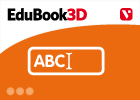Cargando...
Recursos educativos
-
Nivel educativo
-
Competencias
-
Tipología
-
Idioma
-
Tipo de medio
-
Tipo de actividad
-
Destinatarios
-
Tipo de audiencia
-
Creador
Lo más buscado
- Relieve de Australia
- Aprender inglés en cuarto
- Países de África
- Estrategias en el juego
- Repaso de italiano
- Capitales de Asia
- Repaso de restas primaria
- Comparación de razones
- Educación para la Ciudadanía y los Derechos Humanos.
- Actividades educativas para niños en P2
- Descargar ejercicios de quimica
- Imprimir material primero
- Actividades de lógica en sexto
- Patrimonio industrial
- Actividades de lectoescritura en P5
-

Answer. Classification of living things (6)
EduBook Organización
- 940 visitas
What criteria are used to classify protozoa?
-

Final self-evaluation 6 - The Diversity of Life
EduBook Organización
- 931 visitas
Identify if or how each type of protozoa move (pseudopodia, cilia, flagellum or immobile): Amoebas: Paramecium: Plasmodium: Trypanosomes:
-

Final evaluation 4 - The Plant Kingdom
EduBook Organización
- 934 visitas
Explain what vegetative structures mosses have instead of roots, leaves and stems.
-

Answer. Insects 6.2
EduBook Organización
- 932 visitas
What appendages do the head and thorax of an insect have?
-

Answer. Insects 6.3
EduBook Organización
- 936 visitas
What is the relationship between moulting and metamorphosis?
-

Final evaluation 7 - The Animal Kingdom (I). Invertebrates
EduBook Organización
- 937 visitas
What is an arthropod? Name some of their characteristics? List some examples.
-

Investigate. The work of NGOs
EduBook Organización
- 935 visitas
On the Internet, find an example of an NGO that has been in the news recently:
-

Final evaluation 07 - The political organisation of society
EduBook Organización
- 934 visitas
What is the role of NGOs?
-

Final evaluation 09 - Energy and industry
EduBook Organización
- 931 visitas
What is the significance of the workforce, capital and technology in the industrial process?
-

Answer. Trade flows and blocs 03
EduBook Organización
- 940 visitas
Why does information circulate so quickly around the world today?
Te estamos redirigiendo a la ficha del libro...













